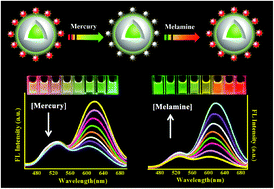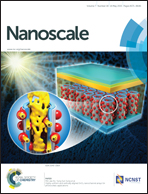Dual-emission fluorescent sensor based on AIE organic nanoparticles and Au nanoclusters for the detection of mercury and melamine†
Abstract
A novel dual-emission ratiometric fluorescence probe is designed and developed by linking two parts, positively charged aggregation-induced emission (AIE) organic fluorescence nanoparticles (OFNs) as the reference and negatively charged Au nanoclusters (Au NCs) as the response, by electrostatic attraction for the first time. This probe can be used for not only visual but quantitative determination of Hg2+ as well as melamine, because red fluorescence of Au NCs can be quenched by mercury ions and recovered by melamine, due to the strong affinity metallophilic Hg2+–Au interaction and stronger affinity Hg2+–N. During this process, the green fluorescence of AIE-OFNs remains constant owing to the protection of ε-polylysine (ε-Ply). In addition, the prepared dual-emission ratiometric fluorescence probe has good biocompatibility, indicating the potential of the probe in applications of biological imaging and detection. The results revealed that this dual-emission ratiometric fluorescence probe broadens the application of AIE-based organic fluorescent nanoparticles, and presents a new method to prepare more sensitive, biocompatible, and visual ratiometric fluorescent probes.

- This article is part of the themed collections: 20th Anniversary of Aggregation-Induced Emission and Editor’s Choice: Making sense of nanosensors and devices

 Please wait while we load your content...
Please wait while we load your content...